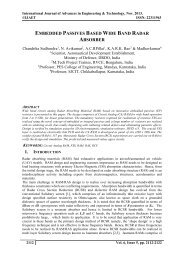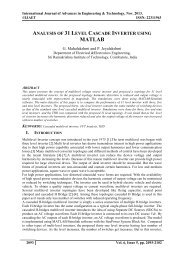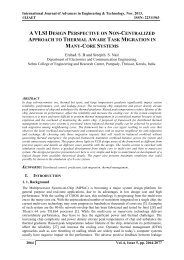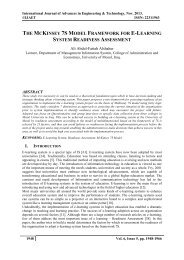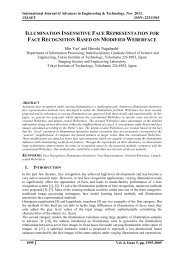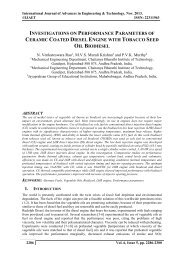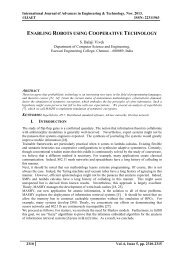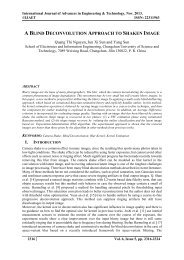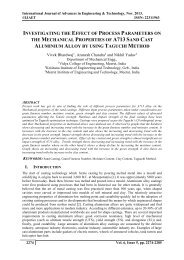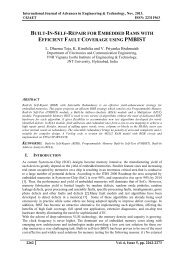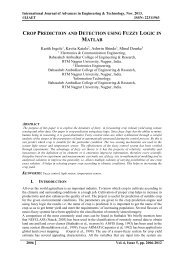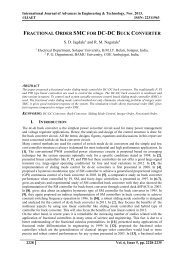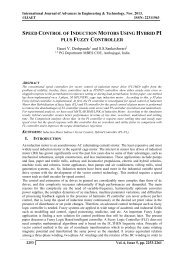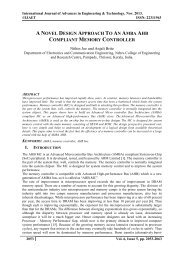A LOGARITHM ENCRYPTION (EA-LOG) OF SYMMETRIC CRYPTOGRAPHY
Cryptography is an area of computer science which is developed to provide security for the senders and receivers to transmit and receive confidential data through an insecure channel. In this paper an Encryption/ Decryption method will be proposed to enhance the frequency latter performance. To protect information from disclosed by the attacker encryption must be apply on the information, the encryption propose is based on logarithm equation, where the logarithm base will be act as the secret key of the algorithm. The strength of the result values for a plaintext is the long key range, but the problem with the relative frequency of the letters. Solving frequency distribution for a language three different methods propose to hide the relative frequency of the letters. However, the methods will add a second level of security on the encrypted information that produces from the logarithm which enhances the security.
Cryptography is an area of computer science which is developed to provide security for the senders and receivers to transmit and receive confidential data through an insecure channel. In this paper an Encryption/ Decryption method will be proposed to enhance the frequency latter performance. To protect information from disclosed by the attacker encryption must be apply on the information, the encryption propose is based on logarithm equation, where the logarithm base will be act as the secret key of the algorithm. The strength of the result values for a plaintext is the long key range, but the problem with the relative frequency of the letters. Solving frequency distribution for a language three different methods propose to hide the relative frequency of the letters. However, the methods will add a second level of security on the encrypted information that produces from the logarithm which enhances the security.
You also want an ePaper? Increase the reach of your titles
YUMPU automatically turns print PDFs into web optimized ePapers that Google loves.
International Journal of Advances in Engineering & Technology, Nov. 2013.<br />
©IJAET ISSN: 22311963<br />
A <strong><strong>LOG</strong>ARITHM</strong> <strong>ENCRYPTION</strong> (<strong>EA</strong>-<strong>LOG</strong>) <strong>OF</strong> <strong>SYMMETRIC</strong><br />
<strong>CRYPTOGRAPHY</strong><br />
Mohammed Abdulridhu Hussain and Zaid Ameen Abduljabbar<br />
Department of Computer Science, College of Education, Basrah University, Basrah, Iraq<br />
ABSTRACT<br />
Cryptography is an area of computer science which is developed to provide security for the senders and<br />
receivers to transmit and receive confidential data through an insecure channel. In this paper an Encryption/<br />
Decryption method will be proposed to enhance the frequency latter performance. To protect information from<br />
disclosed by the attacker encryption must be apply on the information, the encryption propose is based on<br />
logarithm equation, where the logarithm base will be act as the secret key of the algorithm. The strength of the<br />
result values for a plaintext is the long key range, but the problem with the relative frequency of the letters.<br />
Solving frequency distribution for a language three different methods propose to hide the relative frequency of<br />
the letters. However, the methods will add a second level of security on the encrypted information that produces<br />
from the logarithm which enhances the security.<br />
KEYWORDS: Cryptography, Encryption, Decryption, Secret key, symmetric cryptography<br />
I. INTRODUCTION<br />
Cryptography is the science of making communication unintelligible to everyone except the intended<br />
receivers. Cryptography offers efficient solution to protect sensitive information in a large number of<br />
applications including personal data security, internet security, diplomatic and military<br />
communications security, etc. A cryptosystem is a set of algorithm, indexed by some keys(s), for<br />
encoding messages into cipher text and decoding them back into plaintext [1]. Manly encryption<br />
algorithms can be classified into two broad categories- Symmetric and Asymmetric key encryption.<br />
In symmetric Cryptography the key used for encryption is similar to the key used in decryption. Thus<br />
the key distribution has to be made prior to the transmission of information. The key plays a very<br />
important role in symmetric cryptography since their security directly depends on the nature of key<br />
i.e. the key length etc. There are various symmetric key algorithms such as DES, TRIPLE DES, AES,<br />
RC4, RC6, BLOWFISH [2].<br />
In Asymmetric Key encryption, two different keys are used for encryption and decryption- Public and<br />
Private. The public key is meant for general use so it is available to anyone on the network. Anyone<br />
who wants to encrypt the plaintext should know the Public key of receiver. Only the authorized<br />
person can be able to decrypt the cipher text through his own private key. Private Key is kept secret<br />
from the outside world.<br />
Symmetric Encryption Algorithm runs faster as compared to Asymmetric key algorithms. Also the<br />
memory requirement of Symmetric algorithm is lesser as compared to asymmetric.<br />
The core of the encryption algorithm in cryptography is the mathematical equations; the complexity<br />
of the equation does not mean that the algorithm is good. Almost all algorithms based on the modular<br />
arithmetic because each result has a variety of possibility to discover the original number.<br />
Encryption algorithms are used to handle the first security goal which is confidentiality. The attacker<br />
has two methods to break a cipher text, the first method is trying every possible key on a cipher text<br />
until an intelligible translation into plaintext is obtained [3] but with one condition when the algorithm<br />
is known, the second method is determine the relative frequency of the letters in a cipher text and<br />
1977 Vol. 6, Issue 5, pp. 1977-1987
International Journal of Advances in Engineering & Technology, Nov. 2013.<br />
©IJAET ISSN: 22311963<br />
compare to a standard frequency distribution for the language in used and this strategy usually work<br />
for the substituted encryption algorithm.<br />
In this paper we instructed a symmetric encryption algorithm based on the same idea of the modular<br />
but by using mathematic logarithm function with different methods. The propose algorithm is<br />
sophisticate to be broken by the relative frequency method. Moreover, the key is difficult to be<br />
predicted.<br />
The rest of the paper is organized as follows: Section 2 presents the literature review. Section 3 the<br />
propose encryption and decryption algorithms. Section 4 case study as an example. Section 5gives the<br />
test result and discussion. Section 6 conclusion.<br />
II.<br />
RELATED WORK<br />
Visual Cryptography is a technique to make data secure. After dividing image into ‘n’ shares, the<br />
individual shares are sent via different communication channels to destination such that intruder has<br />
less chance to get whole information [4].<br />
Ranjan kumar, et al. [4] this paper focuses on one particular popular technique, Least Significant Bit<br />
(LSB) embedding, using digital images as the medium. The terminology is that a message is hidden<br />
within a cover image to produce a stego-image. Security issue in this paper is encrypting the resulting<br />
Stego-image using symmetric encryption method before share creation. The encryption based on<br />
additive modulo 255 algorithms. Keys are generated using a unique technique called Mixed Key<br />
Generation (MKG). In this method block of size of 8 byte keys are generated using PRN generation<br />
algorithm and individual bits from every bytes is selected.<br />
Janailin, et al. [5] propose a new symmetric key algorithm called as KED (Key Encryption<br />
Decryption) and a new key generation method. The proposed algorithm is used for encryption and<br />
decryption process, using modulo69 and inverse modulo69. The encryption algorithms based on<br />
multiply with key1 and adding with key2. Where key1 is entered by the user, key2 is calculated and<br />
the reverse of key1 will be found for decryption purpose. The decryption algorithm is the reverses of<br />
encryptions which is done through subtraction with key2 and multiply with the reverse value of key1<br />
act as division.<br />
Vishwa gupta, et al. [6] propose an advance cryptography algorithm for improving data security. This<br />
algorithm essentially based on combination of XOR operation and circular shift between the 16<br />
character blocks which is operate on the key and to produce the cipher.<br />
Prof. K. Ravindra Babu, et al. [7] propose new substitution algorithm where the plaintext is<br />
substituted with a color block form the available 18 Deucalion’s of colors in the world, the algorithm<br />
named Play Color Cipher (PCC). Each character from the plaintext will be map into four colors in one<br />
pixel, where the size of the result cipher image will be more than the original plaintext four times.<br />
Ayushi [4] propose a symmetric key cryptographic algorithm which is based on reversing the ASCII<br />
code of a character and divide the result by 4 digits divisor as the key. The algorithm is simple to<br />
implement.<br />
Ankita Agarwal [5] in this paper, a new approach of Genetic Algorithm is proposed in which, the<br />
operations of GA (Crossover and Mutation) are exploited to produce this encryption method. Where<br />
Crossover is swapping two bytes in each 8-byte and Mutation is subtraction of one byte from the<br />
number 255, the selection of bytes to apply the operation on based on a key.<br />
III.<br />
THE PROPOSE ALGORITHM<br />
The propose encryption algorithm embedded the mathematical logarithm function to encrypt the<br />
plaintext as shown in equation (1), where this algorithm can be categorized as substitution method. In<br />
another word each character in plaintext will be replaced with another character. Thus, to cover all<br />
probability of plaintext character, ASCII code is used.<br />
C = log p k<br />
= ln(p)<br />
…………………… (1)<br />
ln(k)<br />
where c is the cipher text, p is the plaintext and k is the secret key.<br />
1978 Vol. 6, Issue 5, pp. 1977-1987
International Journal of Advances in Engineering & Technology, Nov. 2013.<br />
©IJAET ISSN: 22311963<br />
Input<br />
Plaintext<br />
Encryption<br />
Algorithm<br />
Deccryption<br />
Algorithm<br />
Output<br />
Plaintext<br />
<strong>EA</strong>-<strong>LOG</strong><br />
DA-<strong>LOG</strong><br />
3.1 Encryption Algorithm<br />
Figure 1: Symmetric cryptography model<br />
Step1: Consider a plaintext with PL length and k as secret key.<br />
Step2: For i = 1 to PL Do<br />
Read the plaintext character by character as Plaintext (i)<br />
Apply Equation (1) save result in Cipher<br />
Step3: Transform the variable cipher to a ciphertext, three methods are proposed;<br />
Method 1:<br />
- Each integer number converts to one character from the alphabetic string variable.<br />
- Replace all the recurrence characters with the previous position of the same character. The<br />
position will be converted to a character; the maximum position value is equal to the<br />
alphabetic variable length.<br />
Method 2:<br />
- convert each two integer number to one ASCII character<br />
- Replace all the recurrence characters with the previous position of the same character. The<br />
position will be converted to a character; the maximum position value is greater than 127<br />
which is ASCII number.<br />
Method 3:<br />
- convert the cipher numbers to binary and then each 6-bit binary number convert to ASCII<br />
characters<br />
- Replace all the recurrence characters with the previous position of the same character. The<br />
position will be converted to a character; the maximum position value is greater than 127<br />
which is ASCII number.<br />
3.1.1 <strong>EA</strong>-<strong>LOG</strong> Method 1<br />
The result of cipher variable is a real number with a maximum length of five digits. Therefore, to<br />
produce a ciphertext each integer number will be replaced with a character from the alphabetic string<br />
variable.<br />
The Encryption ALGORITHM for method 1<br />
Step1: Append the length (number of digit) for each number in the variable cipher save the result in<br />
variable cipher1.<br />
Step2: For i = 1 to length(cipher1) Do<br />
For j=1 to length(cipher1(i)) do<br />
Each digit number acts as position to the alphabetic variable for produce the<br />
ciphertext, save as cc1 variable.<br />
End for<br />
End for<br />
Step3: For i = 1 to length(cc1) Do<br />
Find the position of cc1(i) in cc1(1 to i-1)<br />
If true (the character is found) and position
International Journal of Advances in Engineering & Technology, Nov. 2013.<br />
©IJAET ISSN: 22311963<br />
Replace the position with the character from the alphabetic.<br />
Save the result as cc11<br />
End if<br />
End for<br />
3.1.2 <strong>EA</strong>-<strong>LOG</strong> METHOD 2<br />
This method converts each two integer numbers to one ASCII character.<br />
The Encryption ALGORITHM for method 2<br />
Step1: Append the length (number of digit) for each number in the variable cipher save the result in<br />
variable cipher1.<br />
Step2: For i = 1 to length(cipher1) Do<br />
For j=1 to length(cipher1(i)) step 2 do<br />
Each two digits converted into one ASCII character, save as cc2 variable.<br />
End for<br />
End for<br />
Step3: For i = 1 to length(cc2) Do<br />
Find the position of cc2(i) in cc2(1 to i-1)<br />
If true (the character is found) and position + 101 > 127 then<br />
Replace the character with the position<br />
Replace the position value with the character from the ASCII.<br />
Save the result as cc22<br />
End if<br />
End for<br />
3.1.3 <strong>EA</strong>-<strong>LOG</strong> METHOD 3<br />
This method will treat the Cipher numbers as binary numbers by taken each time six bit and convert<br />
them to character from the ASCII.<br />
The Encryption ALGORITHM for method 3<br />
Step1: For i = 1 to length(cipher) Do<br />
Convert cipher(i) to binary, save as no variable.<br />
For j=1 to length(no) step 6 do<br />
converted into one ASCII character, save as cc3 variable.<br />
End for<br />
Append the number of characters for each cipher(i) will produces.<br />
End for<br />
Step2: For i = 1 to length(cc3) Do<br />
Find the position of cc3(i) in cc3(1 to i-1)<br />
If true (the character is found) and position + 63 > 127 then<br />
Replace the character with the position<br />
Replace the position value with the character from the ASCII.<br />
Save the result as cc33<br />
End if<br />
End for<br />
3.2 Decryption algorithm<br />
The decryption algorithm in the symmetric cryptography is reverse procedure of the encryption and it<br />
can be written as:<br />
p = key c …………………… (2)<br />
where c is the cipher number and the cipher number will be generated from the ciphertext depending<br />
on the method.<br />
3.2.1 DA-<strong>LOG</strong> Method 1<br />
Step1: Read the key<br />
For i = 1 to length(cc11) Do<br />
Convert the position characters to the original characters, save the result as cc12<br />
variable.<br />
End for<br />
Step2: For i = 1 to length(cc12) Do<br />
1980 Vol. 6, Issue 5, pp. 1977-1987
International Journal of Advances in Engineering & Technology, Nov. 2013.<br />
©IJAET ISSN: 22311963<br />
Convert the characters to the original value from the variable alphabetic by its<br />
location.<br />
End for<br />
Step3: For i=1 to length(cc12) Do<br />
Read the length of each number.<br />
Combine the number (based on the above which is the number of digits)<br />
Save the result as no2.<br />
Apply Equation (2) to produce the plaintext characters.<br />
End for<br />
3.2.2 DA-<strong>LOG</strong> Method 2<br />
Step1: Read the key<br />
For i = 1 to length(cc22) Do<br />
Convert the position characters to the original characters, save the result as cc23<br />
variable.<br />
End for<br />
Step2: For i = 1 to length(cc23) Do<br />
Each character will be converted to two digit numbers.<br />
End for<br />
Step3: For i=1 to length(cc23) Do<br />
Read the length of each number.<br />
Combine the number (based on the above which is the number of digits)<br />
Save the result as no2.<br />
Apply Equation (2) to produce the plaintext characters.<br />
End for<br />
3.2.3 DA-<strong>LOG</strong> Method 3<br />
Step1: Read the key<br />
For i = 1 to length(cc33) Do<br />
Convert the position characters to the original characters, save the result as cc34<br />
variable.<br />
End for<br />
Step3: For i=1 to length(cc34) Do<br />
Read the number of characters for the real number.<br />
Convert the characters to binary numbers and combine the number (based on the<br />
above which is the number of digits) to produce one real number.<br />
Save the result as no2.<br />
Apply Equation (2) to produce the plaintext characters.<br />
End for<br />
IV.<br />
CASE STUDY<br />
In this section given a details example to express the <strong>EA</strong>-<strong>LOG</strong> process. The algorithm implemented in<br />
MATLAB. Assume the following variables:<br />
Plaintext = “network security”<br />
Key = 99<br />
Alphabetic='abcdefghijklmnopqrstuvwxyz';<br />
After applying equation (1) the cipher variable will be:<br />
Cipher = [10229 10043 10344 10400 10248 10307 10169 7542<br />
10326 10043 10000 10363 10307 10128 10344 10436]<br />
Each number represents one plaintext character.<br />
4.1 Method 1 Encryption Process<br />
Cipher1 = [510229 510043 510344 510400 510248 510307 510169 47542<br />
510326 510043 510000 510363 510307 510128 510344 510436]<br />
1981 Vol. 6, Issue 5, pp. 1977-1987
International Journal of Advances in Engineering & Technology, Nov. 2013.<br />
©IJAET ISSN: 22311963<br />
Cc1=<br />
[fbaccjfbaaedfbadeefbaeaafbaceifbadahfbabgjehfecfbadcgfbaaedfbaaaafbadgdfbadahfbabcifbadeefbae<br />
dg]<br />
Cc11=<br />
[fbackjpppkedpponpkpppnlkppmcqipppdlhppnlgjxrrmcmsudovpppkvrppokkkppmtglpppnlhppnlcipnp<br />
vekpppnqg]<br />
4.2 Method 1 Decryption Process<br />
Cc12=<br />
[fbaccjfbaaedfbadeefbaeaafbaceifbadahfbabgjehfecfbadcgfbaaedfbaaaafbadgdfbadahfbabcifbadeefbae<br />
dg]<br />
No2 = [10229 10043 10344 10400 10248 10307 10169 7542 10326<br />
10043 10000 10363 10307 10128 10344 10436]<br />
Plaintext = network security<br />
4.3 Method 2 Encryption Process<br />
Cipher1 = [510229 510043 510344 510400 510248 510307 510169 47542<br />
510326 510043 510000 510363 510307 510128 510344 510436]<br />
Figure 2: cc2 value<br />
Double(cc2) = [51 2 29 51 100 43 51 3 44 51 4 100 51 2 48 51 3 7<br />
51 1 69 47 54 20 51 3 26 51 100 43 51 100 100 51 3 63 51 3<br />
7 51 1 28 51 3 44 51 4 36]<br />
Figure 3: cc22 value<br />
Double(cc22) = [51 2 29 104 100 43 104 3 44 104 4 108 104 113 48 104<br />
110 7 104 1 69 47 54 20 107 110 26 104 118 125 104 104 102 104 110<br />
63 104 104 122 104 122 28 104 107 44 104 4 36]<br />
4.4 Method 2 Decryption Process<br />
Figure 4: cc23 value<br />
No2 = [10229 10043 10344 10400 10248 10307 10169 7542 10326<br />
10043 10000 10363 10307 10128 10344 10436]<br />
Plaintext = network security<br />
4.5 Method 3 Encryption Process<br />
Figure 5: cc3 value<br />
Double(cc3) = [3 2 31 53 3 2 28 59 3 2 33 40 3 2 34 32 3 2 32<br />
8 3 2 33 3 3 2 30 57 3 1 53 54 3 2 33 22 3 2 28 59 3<br />
2 28 16 3 2 33 59 3 2 33 3 3 2 30 16 3 2 33 40 3 2 35<br />
4]<br />
Figure 6: cc33 value<br />
Double(cc33) = [3 2 31 53 67 67 28 59 67 67 33 40 67 67 34 32 67<br />
67 66 8 67 67 75 66 64 67 30 57 67 1 90 54 67 71 75 22 67 67<br />
95 95 67 67 67 16 67 67 75 71 67 67 67 66 64 67 91 75 67 67 71<br />
111 67 67 35 4]<br />
4.6 Method 3 Decryption Process<br />
1982 Vol. 6, Issue 5, pp. 1977-1987
International Journal of Advances in Engineering & Technology, Nov. 2013.<br />
©IJAET ISSN: 22311963<br />
Figure 7: cc34 value<br />
No2 = [10229 10043 10344 10400 10248 10307 10169 7542 10326<br />
10043 10000 10363 10307 10128 10344 10436]<br />
Plaintext = network security<br />
V. RESULT & DISCUSSION<br />
Experiment 1<br />
Plaintext = symmetric Cryptography<br />
Key= 99<br />
Table 1: experiment (1) - ciphertext ASCII for method 1<br />
102 98 97 100 99 103 112 112 112 101 113 112 112 112 112 117 108<br />
106 112 112 110 112 108 112 112 112 110 107 101 100 112 112 111 110<br />
112 107 112 112 112 112 108 104 112 112 110 108 99 105 112 110 112<br />
107 107 107 101 120 114 109 118 108 106 118 112 116 108 110 109 100<br />
108 120 112 112 110 120 113 103 112 112 112 99 111 105 112 112 112<br />
117 119 107 112 112 112 118 111 118 112 112 112 107 111 103 112 112<br />
111 100 108 104 120 106 107 115 107 107 117 115 99 122 105 112 112<br />
112 108 108 104 112 110 110 101 100 119 109 114 114 109 99<br />
Figure 8: experiment (1) - Ciphertext for method 1<br />
Table 2: experiment (1) - ciphertext ASCII for method 2<br />
51 3 26 104 4 36 104 2 9 104 104 104 104 100 43 104 116 44<br />
104 104 7 104 1 28 104 113 102 47 54 20 49 15 107 110 116 116<br />
104 4 36 104 2 68 104 110 44 104 107 48 104 118 86 104 110 119<br />
125 95 50 107 113 119 104 1 110 104 4 36 47 54 20<br />
Figure 9: experiment (1) - Ciphertext for method 2<br />
Table 3: experiment (1) - ciphertext ASCII for method 3<br />
3 2 33 22 67 67 35 4 67 67 31 72 67 67 67 67 67 67 28 59<br />
67 67 70 40 67 67 67 66 64 67 30 16 67 67 79 67 67 1 53 54<br />
67 71 14 62 67 67 83 66 64 67 107 107 67 67 32 84 67 67 75 99<br />
67 67 71 8 67 67 29 38 67 67 75 66 64 67 27 88 67 67 79 87<br />
67 67 79 127 67 67 74 99 67 115 115 115<br />
Experiment 2<br />
Plaintext = symmetric Cryptography<br />
Key= 31<br />
Figure 10: experiment (1) - Ciphertext for method 3<br />
1983 Vol. 6, Issue 5, pp. 1977-1987
International Journal of Advances in Engineering & Technology, Nov. 2013.<br />
©IJAET ISSN: 22311963<br />
Table 4: experiment (2) - ciphertext ASCII for method 1<br />
102 98 100 105 109 104 112 109 112 106 103 111 107 112 112 111 107<br />
110 112 108 112 111 107 110 112 108 112 101 108 106 112 112 110 105<br />
113 99 112 112 112 104 117 112 112 112 112 109 107 112 108 112 112<br />
107 105 110 112 108 97 107 106 118 112 112 109 107 101 107 112 112<br />
100 104 118 114 112 112 112 111 103 111 107 112 112 118 101 97 112<br />
112 112 105 112 99 112 112 112 118 109 113 112 109 112 110 106 103<br />
112 112 112 118 112 99 112 112 112 107 111 110 112 108 111 118 101<br />
97 112 112 112 109 118 113 109 112 112 106 103 111 107 112 121 107<br />
113 119<br />
Figure 11: experiment (2) - Ciphertext for method 1<br />
Table 5: experiment (2) - ciphertext ASCII for method 2<br />
51 38 17 104 39 65 104 36 61 104 104 104 104 34 111 104 116 42<br />
104 37 92 104 35 52 104 33 81 104 100 110 104 22 44 104 116 107<br />
104 124 65 104 107 40 104 38 42 104 107 14 104 34 96 104 107 119<br />
104 33 21 104 107 119 104 35 24 104 39 65 104 100 116<br />
Figure 12: experiment (2) - Ciphertext for method 2<br />
Table 5: experiment (2) - ciphertext ASCII for method 3<br />
3 64 23 57 66 64 26 65 66 64 21 29 66 64 67 67 66 64 17 63<br />
66 64 24 18 66 64 87 32 66 64 19 48 66 64 79 5 66 2 86 44<br />
67 67 86 20 67 64 83 83 66 64 107 107 66 64 22 79 66 64 99 99<br />
66 64 71 67 66 64 66 56 66 64 87 87 66 64 16 9 66 64 79 87<br />
66 64 115 103 66 64 99 99 66 111 115 75<br />
Experiment 3<br />
Plaintext = net!_work.@<br />
Key= 26<br />
Figure 13: experiment (2) - Ciphertext for method 3<br />
Table 6: experiment (3) - ciphertext ASCII for method 1<br />
102 98 101 107 99 104 112 112 111 108 103 111 107 110 112 109 106 97<br />
109 112 109 122 100 110 112 108 110 117 113 107 112 112 66 71 107 105<br />
112 112 112 107 110 108 108 112 109 109 68 119 109 112 112 111 108 99<br />
112 112 107 76 110 109 108 108 115 112 65 119<br />
Figure 14: experiment (3) - Ciphertext for method 1<br />
Table 7: experiment (3) - ciphertext ASCII for method 2<br />
51 44 27 104 41 65 104 45 90 104 7 31 104 39 77 104 46 68<br />
104 119 54 104 116 36 104 43 42 104 17 103 102 27 64<br />
Figure 15: experiment (3) - Ciphertext for method 2<br />
1984 Vol. 6, Issue 5, pp. 1977-1987
International Journal of Advances in Engineering & Technology, Nov. 2013.<br />
©IJAET ISSN: 22311963<br />
Table 8: experiment (3) - ciphertext ASCII for method 3<br />
3 64 33 27 66 64 29 21 66 64 35 62 66 2 39 43 67 64 26 25<br />
66 64 37 12 66 64 87 54 66 64 83 8 66 64 32 6 66 87 55 88<br />
67 64 7 28<br />
Figure 16: experiment (3) - Ciphertext for method 3<br />
In this work we proposed a schema in symmetric cryptography named as <strong>EA</strong>-<strong>LOG</strong>, where encryption<br />
and decryption algorithms are described with three main methods. The result of the propose schema<br />
provide a secure ciphertext by providing infinite key length.<br />
The general problem of the symmetric cryptography algorithms is the sharing of the secret key. The<br />
solution of such problem by using either RSA or Diffie-Hellman key exchange which is produces a<br />
single number on each side and it suitable for the above algorithm. Figure 17 shows the cipher vs. the<br />
key length for character (a). Increasing the key Length will decrease the result of the encryption<br />
algorithm, and that will result reducing the ciphertext characters.<br />
Figure 17: key and the cipher value for character (a)<br />
The first method consumes the bandwidth but it is the simplest. However, to make the method more<br />
difficult simply change the sequence of character in the alpha variable.<br />
The second method increasing the key value will result smaller value of the cipher variable which is<br />
in term reduce the ciphertext characters, in other word, the cipher value less than five integer number.<br />
The problem in the receiver side how to discover how many character for each number, one solution<br />
is to add the length to the ciphertext.<br />
The third method will handle the result in binary level. The best way to combine the binary result for<br />
all numbers then converts them to characters, to reduce the ciphertext characters.<br />
The result ASCII code from the above methods could be unknown character where it must handle<br />
through programming.<br />
VI.<br />
CONCLUSIONS<br />
The aim of this paper is creating a symmetric algorithm for encryption and decryption, to protect the<br />
information from discloses by the attacker and defeats the frequency distributed for the language.<br />
The <strong>EA</strong> - <strong>LOG</strong> on the basis of the logarithm equation with three different methods to deal with the<br />
outcome that results from the logarithm. This paper demonstrated the relative frequency of the letter is<br />
1985 Vol. 6, Issue 5, pp. 1977-1987
International Journal of Advances in Engineering & Technology, Nov. 2013.<br />
©IJAET ISSN: 22311963<br />
unrecognizable, in other hand, hiding the frequent of letters add another level of security which is<br />
hiding the relationship between the plaintext and the ciphertext. <strong>EA</strong>-<strong>LOG</strong> is good for small amount of<br />
plaintext and easy to implement.<br />
The strength of the algorithm in the key value causes by the large key range, huge number of<br />
possibility of plaintext character value for a single cipher text because the nature of the logarithm,<br />
moreover, will made the job of the brute force attack more sophisticated. The purpose of the second<br />
security level of the algorithm is to masking plaintext-ciphertext relation from cryptanalysis attack.<br />
VII.<br />
FUTURE WORK<br />
To reduce the result size of the <strong>EA</strong>-<strong>LOG</strong> algorithm ciphertext image will be produce by map the<br />
logarithm result on an Image. In other word, the result ciphertext of the algorithm is large compared<br />
with the plaintext because the result from logarithm is real numbers; the image map is take the real<br />
number as density of each colour pixel.<br />
Apply diffie-hellman key exchange [3] to share the key on both the sender and the receiver ends.<br />
REFERENCES<br />
[1]. Ankita Agarwal, (2012) ” Secret Key Encryption Algorithm Using Genetic Algorithm”, International<br />
Journal of Advanced Research in Computer Science and Software Engineering, Volume 2, Issue 4.<br />
[2]. Diaa Salama, Abdul. Elminaam, Hatem Mohamed, Abdul Kader and Mohie Mohamed Hadhoud,<br />
(2008) “Performance Evaluation of Symmetric Encryption Algorithms”, International Journal of<br />
Computer Science and Network Security,vol.8 No.12.<br />
[3]. William Stallings, (2005) “Cryptography and Network Security Principles and Practices”, Fourth<br />
Edition, Prentice Hall.<br />
[4]. Ranjan Kumar H S, Prasanna Kumar H R, Sudeepa K B and Ganesh Aithal, (2013) "ENHANCED<br />
SECURITY SYSTEM USING <strong>SYMMETRIC</strong> <strong>ENCRYPTION</strong> AND VISUAL <strong>CRYPTOGRAPHY</strong>",<br />
International Journal of Advances in Engineering & Technology.<br />
[5]. Janailin Warjri, Dr. E. George Dharma Prakash Raj, (2013) "KED - A Symmetric Key Algorithm for<br />
Secured Information Exchange Using Modulo 69 ", I. J. Computer Network and Information Security.<br />
[6]. Vishwa gupta, Gajendra Singh , Ravindra Gupta, (2012) "Advance cryptography algorithm for<br />
improving data security", International Journal of Advanced Research in Computer Science and<br />
Software Engineering, Volume 2, Issue 1.<br />
[7]. Prof. K. Ravindra Babu, Dr .S.Udaya Kumar, Dr. A.Vinaya Babu and Dr. Thirupathi Reddy, (2010) "A<br />
Block Cipher Generation using Color Substitution ", International Journal of Computer Applications.<br />
[8]. Ayushi, (2010) "A Symmetric Key Cryptographic Algorithm", International Journal of Computer<br />
Applications, Volume 1 – No. 15.<br />
[9]. Prof. NavinRajpal,Ravindra Kumar Chahar, GoutamDatta, (2007) " Design of a New Security<br />
Protocol", International Conference on Computational Intelligence and Multimedia Applications.<br />
[10]. HimaniAgrawal ,Monisha Sharma, (2010) "Implementation and analysis of various symmetric<br />
cryptosystems", Indian Journal of Science and Technology, Vol. 3 No. 12.<br />
[11]. DiaaSalamaAbdElminaam, Hatem Mohamed Abdual Kader, Mohiy Mohamed Hadhoud, (2010)<br />
"Evaluating The Performance of Symmetric Encryption Algorithms", International Journal of Network<br />
Security, Vol.10, No.3, PP.216–222.<br />
[12]. Huy Hoang Ngo, Xianping Wu, Phu Dung Le, Campbell Wilson, ,Balasubramaniam Srinivasan, (2010)<br />
"Dynamic Key Cryptography and Applications", International Journal of Network Security, Vol.10,<br />
No.3, PP.161-174.<br />
[13]. Sunil Taneja, Ashwani Kush, C. Jinshong Hwang,(2011) " Secret Key Establishment for Symmetric<br />
Encryption over Adhoc Networks", Proceedings of the World Congress on Engineering and Computer<br />
Science, Vol II<br />
[14]. DiaaSalama Abdul. Elminaam, Hatem M. Abdul Kader ,Mohie M. Hadhoud,(2009) "Performance<br />
Evaluation of Symmetric Encryption Algorithms on Power Consumption for Wireless Devices",<br />
International Journal of Computer Theory and Engineering, Vol. 1, No. 4.<br />
[15]. Zeenat Mahmood, J. L Rana, Prof. Ashish khare, (2012) "Symmetric Key Cryptography using<br />
Dynamic Key and Linear Congruential Generator (LCG) ", International Journal of Computer<br />
Applications , Volume 50– No.19.<br />
1986 Vol. 6, Issue 5, pp. 1977-1987
International Journal of Advances in Engineering & Technology, Nov. 2013.<br />
©IJAET ISSN: 22311963<br />
AUTHOR<br />
Mohammed Abdul Ridha Hussain received the Bachelor of Computer Science<br />
degree in computer engineering from college of engineer Basrah University, Iraq,<br />
2004. The Master of technology in Computer Science and Engineer, from GGS<br />
Indraprastha University, India, 2009. Working in Department of Computer<br />
Science, College of Education, Basrah University, Basrah, Iraq with 3 years of<br />
teaching experience.<br />
Zaid Ameen AbdulJabbar received the Bachelor of Computer Science degree from<br />
college of science Basrah University, Iraq, 2001. The Master of computer science from<br />
college of science Basrah University, Iraq, 2006. Working in Department of Computer<br />
Science, College of Education, Basrah University, Basrah, Iraq with 4 years of teaching<br />
experience.<br />
1987 Vol. 6, Issue 5, pp. 1977-1987




